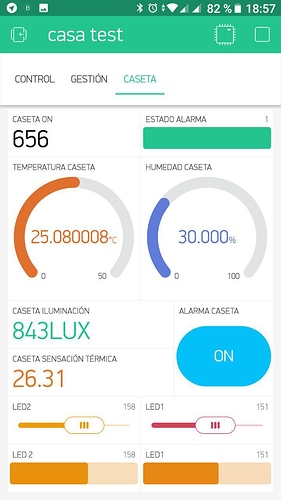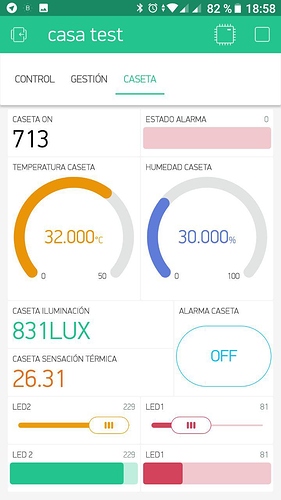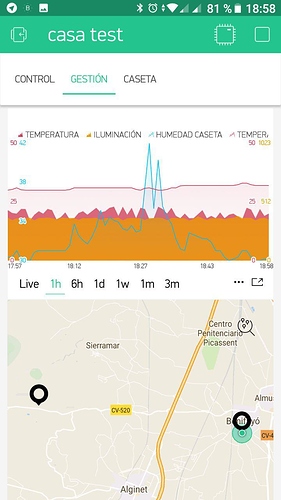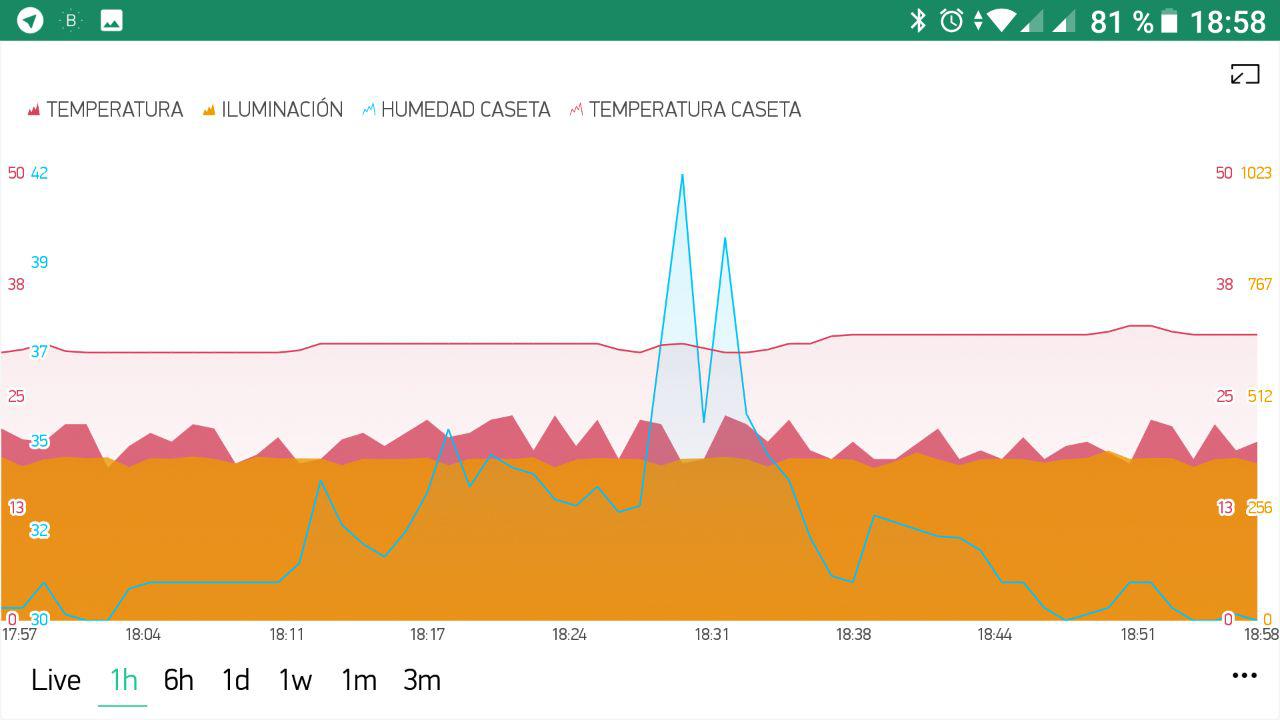Hello,
I just finish my prototype about use a motion sensor as a surveillance system from my home. the idea is create a box with arduino and several sensors and actuators like:
- 2 LED with intensity control
- 1 Humidity and temperature sensor (DHT11)
- photoresistor
- Motion sensor
with this hardware setup I want to reach the follow Items:
- detect movement when I activate a bottom, If not activated motion sensor disabled.
- to know when the alarm is activated
- control both LEDS independently with ligth regulator
- To know in which luminosoty state are the LEDS
- see the temperature
- see the humidity
- see the thermal feeling (feature of the DHT11 library)
- see the luminosity
- see how many time my device is ON
- see the values on a graph
- locate my device on a map
- notify when temperature is high
- notify when humidity is high
- notify when luminosity is high
- NOTIFY ME WHEN ALARM IS ON AND DETECT MOVEMENT
- launch a sound through a lodspeakes
- send control parameters by serial port to control the variable states.
On the begining my hardware was an Arduino UNO + ESP8266-01 as a wifi shield but the ESP8266 on this behavior is too slow and the Arduino get freeze too often.
So I decide to use an Ethernet shield instead the ESP8266 and the performance looks great¡¡
here some screens about the dashboard:
here my code that I use:
/* Comment this out to disable prints and save space */
#define BLYNK_PRINT Serial
#include <SPI.h>
#include <Ethernet.h>
#include <BlynkSimpleEthernet.h>
char auth[] = "ooooooo";
#define W5100_CS 10
#define SDCARD_CS 4
#include <DHT.h>
int LDR = A1;
const int LEDPin = 13; // pin para el LED
const int PIRPin = 8; // pin de entrada (for PIR sensor)
int val = LOW; // estado del pin
int lux;
int alarma = 0;
int ultalarma = 0;
int led1 = 5;
int led2 = 6;
int estled1 = 0;
int estled2 = 0;
float t;
float h;
float hif;
#define DHTPIN 7 // What digital pin we're connected to
#define DHTTYPE DHT11 // DHT 11
DHT dht(DHTPIN, DHTTYPE);
BlynkTimer timer;
WidgetMap myMap(V1);
void setup()
{
pinMode(PIRPin, INPUT);
pinMode (9, OUTPUT);
pinMode(led1, OUTPUT);
pinMode(led2, OUTPUT);
pinMode(LEDPin, OUTPUT);
// Debug console
Serial.begin(9600);
pinMode(SDCARD_CS, OUTPUT);
digitalWrite(SDCARD_CS, HIGH); // Deselect the SD card
Blynk.begin(auth);
dht.begin();
timer.setInterval(700L, notis);
timer.setInterval(1000L, sensores);
timer.setInterval(10000L, sensores2);
timer.setInterval(3000L, sensores3);
myMap.location(2, ******, -********, "caseta");
myMap.location(1, ********, ******, "casa");
}
void loop()
{
Blynk.run();
timer.run();
movimiento();
}
void movimiento() {
if (alarma==HIGH){
val = digitalRead(PIRPin);
if (val == HIGH) {
digitalWrite(LEDPin, HIGH);
tone(9, 659.26, 100);
}
else {
digitalWrite(LEDPin, LOW);
val = LOW;
}
}
}
void sensores2() {
Blynk.virtualWrite(V5, h);
Blynk.virtualWrite(V6, t);
Serial.print(h);
Serial.println(" humedad");
Serial.print(t);
Serial.println(" temp");
}
void sensores3() {
Blynk.virtualWrite(V7, millis() / 1000);
Blynk.virtualWrite(V16, hif);
Blynk.virtualWrite(V8, lux);
Serial.print( millis() / 1000);
Serial.println(" segundos");
Serial.print(hif);
Serial.println(" sensacion termica");
Serial.print(lux);
Serial.println(" lux");
}
void sensores() {
Blynk.virtualWrite(V10, estled1);
Blynk.virtualWrite(V12, estled2);
Blynk.virtualWrite(V15, alarma);
Serial.print(estled1);
Serial.println(" led1");
Serial.print(estled2);
Serial.println(" led2");
Serial.print(val);
Serial.print(alarma);
Serial.println(" 1 +1 alarma ON");
}
void notis() {
h = dht.readHumidity();
t = dht.readTemperature();
hif = dht.computeHeatIndex(t, h);
lux = analogRead(LDR);
if (val == HIGH) {
Blynk.notify("caseta MOVIMIENTO!");
}
if (t >= 33) {
Blynk.notify("caseta alta temperatura!");
}
if (h >= 80) {
Blynk.notify("caseta alta humedad!");
}
if (lux >= 980) {
Blynk.notify("caseta iluminacion");
}
Serial.println(" notis");
}
BLYNK_WRITE(V9)
{
estled1 = param.asInt();
analogWrite(led1, estled1);
}
BLYNK_WRITE(V11)
{
estled2 = param.asInt();
analogWrite(led2, estled2);
}
BLYNK_WRITE(V14)
{
alarma = param.asInt(); // assigning incoming value from pin V14 to a variable
}
The project works very nice and only remains to put all hardware on a plastic box and conect close to the main gate of my home to get control of the intruders when I will be out of home¡¡¡



